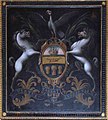Fasces is a bound bundle of wooden rods, often but not always including an axe with its blade emerging. The fasces is an Italian symbol that had its origin in the Etruscan civilization and was passed on to ancient Rome, where it symbolized a Roman king's power to punish his subjects, and later, a magistrate's power and jurisdiction. The axe has its own separate and older origin. Initially associated with the labrys, the double-bitted axe originally from Crete, is one of the oldest symbols of Greek civilization.

A coat of arms is a heraldic visual design on an escutcheon, surcoat, or tabard. The coat of arms on an escutcheon forms the central element of the full heraldic achievement, which in its whole consists of a shield, supporters, a crest, and a motto. A coat of arms is traditionally unique to the armiger. The term "coat of arms" itself, describing in modern times just the heraldic design, originates from the description of the entire medieval chainmail "surcoat" garment used in combat or preparation for the latter.

The coat of arms of Canada, also known as the Royal Coat of Arms of Canada or, formally, as the Arms of His Majesty The King in Right of Canada, is the arms of dominion of the Canadian monarch and, thus, also the official coat of arms of Canada. In use since 1921, it is closely modelled after the royal coat of arms of the United Kingdom, with French and distinctive Canadian elements replacing or added to those derived from the British version.

The flag of Georgia is the flag of the U.S. state of Georgia. Its current iteration was adopted on February 19, 2003. The flag bears three horizontal stripes and features a blue canton containing a ring of 13 white stars that encircle the state's gold-colored coat of arms. The ring of stars that encompass the state's coat of arms represents Georgia as one of the original Thirteen Colonies.

The coat of arms of the Philippines features the eight-rayed sun of the Philippines with each ray representing the eight provinces which were placed under martial law by Governor-General Ramón Blanco Sr. during the Philippine Revolution, and the three five-pointed stars representing the three major island groups of Luzon, the Visayas, and Mindanao.

The flag of the state of Michigan is a coat of arms set on a dark blue field, as set forth by Michigan state law. The governor has a variant of the flag with a white field instead of blue one. The state has an official flag month from June 14 through July 14.

The coat of arms of Australia, officially the Commonwealth Coat of Arms, is a formal symbol of the Commonwealth of Australia. It depicts a shield, containing symbols of Australia's six states, and is held up by native Australian animals, the kangaroo and the emu. The seven-pointed Commonwealth Star surmounting the crest also represents the states and territories, while golden wattle, the national floral emblem, appears below the shield.

The flag of Pennsylvania consists of a blue field on which the state coat of arms is displayed.

The flag of West Virginia is the official flag of the U.S. State of West Virginia and was officially adopted by the West Virginia Legislature on March 7, 1929. The present flag consists of a pure white field bordered by a blue stripe with the coat of arms of West Virginia in the center, wreathed by Rhododendron maximum and topped by an unfurled red ribbon reading, "State of West Virginia." It is the only state flag to bear crossing rifles, meant to illustrate the importance of the state's fight for liberty during the Civil War as the southern unionist 35th state.

The coat of arms of the Republic of Serbia consists of two main heraldic symbols which represent the identity of the Serbian state and Serbian people across the centuries: the Serbian eagle and the Serbian cross. The coat of arms also features the Serbian historical crown; while unusual for republics, it is not unprecedented, as can be seen in coat of arms of numerous European countries with republican form of government.

The seal of the president of the United States is used to mark correspondence from the president of the United States to the U.S. Congress, and is also used as a symbol of the presidency itself. The central design, based on the Great Seal of the United States, is the official coat of arms of the U.S. presidency and also appears on the presidential flag.

The Great Seal of the State of Michigan depicts the coat of arms of the U.S. state of Michigan on a light blue field. On the dark blue shield the Sun rises over a lake and peninsula, a man holding a long gun with a raised hand represents peace and the ability to defend his rights. The elk and moose are symbols of Michigan, while the bald eagle represents the United States.

The national emblem of Indonesia is called Garuda Pancasila. The main part is the Garuda with a heraldic shield on its chest and a scroll gripped by its legs. The shield's five emblems represent Pancasila, the five principles of Indonesia's national ideology. The Garuda claws gripping a white ribbon scroll inscribed with the national motto Bhinneka Tunggal Ika written in black text, which can be loosely translated as "Unity in Diversity". Garuda Pancasila was designed by Sultan Hamid II from Pontianak, supervised by Sukarno, and was adopted as the national emblem on 11 February 1950.

The Great Seal of the State of Alabama is the state seal of the U.S. state of Alabama.

The Seal of the Commonwealth of Kentucky was adopted in December 1792. Since that time, it has undergone several revisions. The current seal depicts two men, one in buckskin, and the other in more formal dress. The men are facing each other and clasping hands. The outer ring of the seal is adorned with the words "Commonwealth of Kentucky", and within the inner circle is the state motto "United we stand, divided we fall." The official colors of the seal are blue and gold. A version of the seal appears on the flag of Kentucky.

The Great Seal of the Commonwealth of Pennsylvania is the state seal for the Commonwealth of Pennsylvania. According to the state's website, the seal was authorized by the Pennsylvania General Assembly in 1791, and is "a symbol of authenticity which verifies that proclamations, commissions and other papers of state are legal and official."

The coat of arms of Montenegro was officially adopted by the law passed in the Parliament on 12 July 2004. It is now the central motif of the flag of Montenegro, as well as the coat of arms of the Armed Forces of Montenegro. It was constitutionally sanctioned by the Constitution proclaimed on 2 October 2007.

The coat of arms of Alabama depicts a shield upon which is carried the symbols of the five states which have at various times held sovereignty over a part or the whole of what is now Alabama. These are the ancient coat of arms of France, the ancient coat of arms of Crown of Castile for Spain, the modern Union Jack of the United Kingdom and the battle flag of the Confederate States. On an escutcheon of pretence is borne the shield of the United States. The crest of the coat represents a ship which brought the French colonists who established the first permanent European settlements in the territory. Below is the state motto: Audemus jura nostra defendere, meaning "We dare defend our rights."

The coat of arms of Mexico is a national symbol of Mexico and depicts a Mexican (golden) eagle perched on a prickly pear cactus devouring a rattlesnake. The design is rooted in the legend that the Aztec people would know where to build their city once they saw an eagle eating a snake on top of a lake. The image has been an important symbol of Mexican politics and culture for centuries. To the people of Tenochtitlan, this symbol had strong religious connotations, and to the Europeans, it came to symbolize the triumph of good over evil.
The coats of arms of the U.S. states are coats of arms, that are an official symbol of the state, alongside their seal. Eighteen states have officially adopted coats of arms. The former independent Republic of Texas and Kingdom of Hawaii each had a separate national coat of arms, which are no longer used.


































